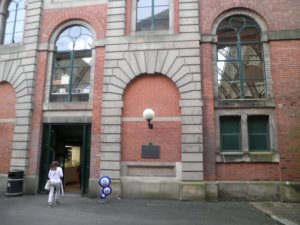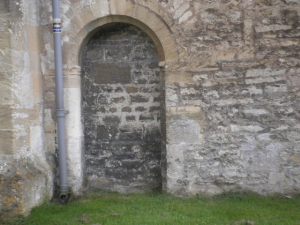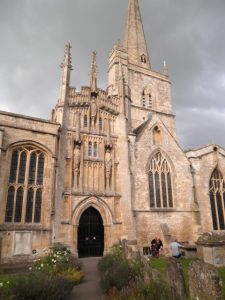Part of the research element of this module is to research medieval architecture in my local area – with Derby this has proved more difficult than expected and also I am unable to walk too far presently so was not able to wander around on foot looking for any length of time but did manage to find a couple of unexpected buildings whose history I shamefully had no idea of.
The first building is Derby Central Library which apparently was designed in the Domestic Flemish Gothic style by Richard Knill Freeman and the library was established in 1879. I was struck less by the whole building but the medieval style entrance – there is a slightly arched doorway with a grander rounded, almost Norman, style surround and this doorway has adjoining arched windows. The original purpose of the building was as a library and also museum and I suspect the doorway was done in this style to give a grand entrance which also feels welcoming too.
Another unexpected building was the Market Hall in Derby which apparently was the first of its kind in Britain! It opened in 1866 with a performance of Handel’s Messiah – I can personally understand how special this would have been considering the interior is very much an open space with a gallery running around the interior of the building with what are now individual shops, a vast open space for stalls below and a huge domed roof. The arched windows and some of the ironwork within them remind me very much of Norman churches and albeit in a very simplistic manner of the impression of the lead in stained glass – however the ironwork is a tribute to the fact that at the time of building Derby was very much an industrial town and important centre of the railway industry (as it still is). There are also two stone arched ‘windows’ that have been either bricked up at a later date or were designed in this fashion – the surrounds of these openings seem to be a facade but I am focusing on the shape as again it strikes me as similar to Norman arches. Both the windows and these openings may have been done this way as it is an elegant design that enabled a lot of natural light to flood into the building. The entrance ways into the building are a mix of styles including Greek classical style and combined with Norman or Roman arches – whichever style inspired the architect, ( I have been unable to find his name at present), the windows and entrance ways into the building give appearances of grandeur and a statement to the town.
St Mary’s Catholic Church – I have done an extensive blog on the history of this building but it is a Victorian Gothic design by the architect Pugin and is wonderfully formal in style and stunningly beautiful inside. St Mary’s is classed as Pugin’s masterpiece and it is without doubt deserving of that description.
I was unable to find many architectural buildings with Romanesque or Gothic inspired design within Derby and I think this is because of the fact it is very much an industrial city and has been since the time of the Industrial Revolution. Much of the building within the city date from this period and are Victorian Gothic in style or seem to be inspired by Classical Greece for their entrances and frontal façades – columns and friezes are seen on the Guildhall Theatre in front of the Market Hall and elsewhere. As a point of note the theatre was original Derby’s Town Hall at the time of the building of the Market Hall (the Town Hall was built in 1841).
However looking for Norman architecture (Romanesque) meant I always had my camera with me and on a brief visit to some family in Oxfordshire I came across St John the Baptist Church in Burford – sadly it was closed at the time of the visit but I was able to photograph the Norman doorways. The church was original begun in 1160 to replace an earlier one on the site and even though some of the doorways were bricked up as the church expanded in size you are able to see them clearly – as you go around the building just on the outside you are able to trace its history and feel as if you are walking through the ages.
Above is a simple Norman doorway tucked to one side of the church – I do wonder if this was either the priest’s entrance or indeed an original entrance to the church nave itself.
This appears to be a much more ornate door of the same period perhaps and the surrounding architecture has beautifully detailed zig-zag carved mouldings which are a feature of Norman architectures. This leads me to think this may have either been the main entrance to the church at the time of its original building. I really love the heavy wooden door with the metalwork hinging and detailing along with the studs of the framework – presumably this is a later addition but done to replicate the original if is not indeed dating from the period.
This doorway appears to be later in period and more Gothic in style than the earlier Norman doors – the slightly pointed archway tells of a later addition to the church and again I wonder whether it became a main entrance if an earlier doorway was bricked up or a side entrance to the church. The style is simple and looking at the top of the arch of the surround wonder whether it was done at during the later Norman style when it started to cross into the early Gothic style period.
This is a picture of the front of St John the Baptist Church and shows the church in its full glory – it was built between 1160 and 1475 and the contrasts between the Norman features and early Gothic style can be seen on the building and my photographs above. The church became grander in style with the pointed arched windows and doorways of the Gothic period along with the height that is so typical of the style.
A further example of the style is seen in a more local church to myself – St Chad, Wilne just near Derby. Parts of this church date from the 13th Century and parts from the 14th Century and the windows and doorway are in clear early Gothic style with the pointed arches but the interior itself strikes as quite dark which is a surprise for the exterior style and can only be explained logically by the amount of work that has been done to the building over the centuries. It is an exceptionally pretty rural church with almost castle-like ramparts along the roof which add architectural detail. The aspect that does not ‘fit’ with Gothic architecture is the fact that this is not a tall building and that may merely be down to the rural location or whether it was removed at some point in the Church’s history due to damage and cost of restoration but I have not found any mention of this. Inside there is a font that dates from the 7th to 9th Centuries so this church has a long history and has served its community through that the intervening centuries.
I do intend to go back to St Chad’s Church during the course of the next module to do some more research as the church has undergone several changes and it will be interesting to see if I can talk to the Vicar or priest who may be able to point out some features of special interest or ‘inside’ knowledge of the building that is not always obvious.
UPDATE JANUARY 2017: Unfortunately I was unable to re-visit the St Chad’s Church during the rest of this course but it is still my intent to study the church further and discover more of its history for personal interest.
BIBLIOGRAPHY:
Burford Benefice. 2015. Burford Church History. Online. Available at: http://www.burfordchurch.org/timeline_and_guide.php
Diocese of Derby. 2012. Wilne, St Chad. Online. Available at: http://derbyshirechurches.org/church/wilne-st-chad
docbrowninfo. No date available. Online. Available at: http://www.docbrown.info/docspics/midlands/mspage35.htm
wikipedia. 2015. Derby Museum and Art Gallery. Online. Available at: https://en.wikipedia.org/wiki/Derby_Museum_and_Art_Gallery








